Touring three crypto-backed platforms without using a VR headset or a crypto wallet
As an outsider coming in mainly from video games, I am skeptically interested in the metaverse. Its promise of a space to express ourselves as we do in our daily life, with digital fashion, hugging, and dancing, as well as the opportunity to “meet” remotely, keep many eagerly following the development of the budding Web 3.0 initiative.
Driven by both my personal finances and my expectations of how an “average person” would interact with the metaverse, I wanted to visit as many metaverses as I could without VR or a crypto wallet and produce a kind of travelog. The term “metaverse” is closely tied to the rise of crypto-based services, while long running social platforms like VRChat and Roblox actively deny the label. Some pre-existing platforms like Second Life have retroactively embraced the label and the blockchain, but my interest lies in seeing if these newer services are doing enough to back their broad promises.
Getting Online
The two metaverses I spent time in were easy enough to enter. Decentraland is very friendly to jump directly into from your browser if your computer can handle the burden on memory. I am not so lucky, so I downloaded and used Decentraland’s desktop app. While it’s an extra step, it was easier to set up than making a new email address.
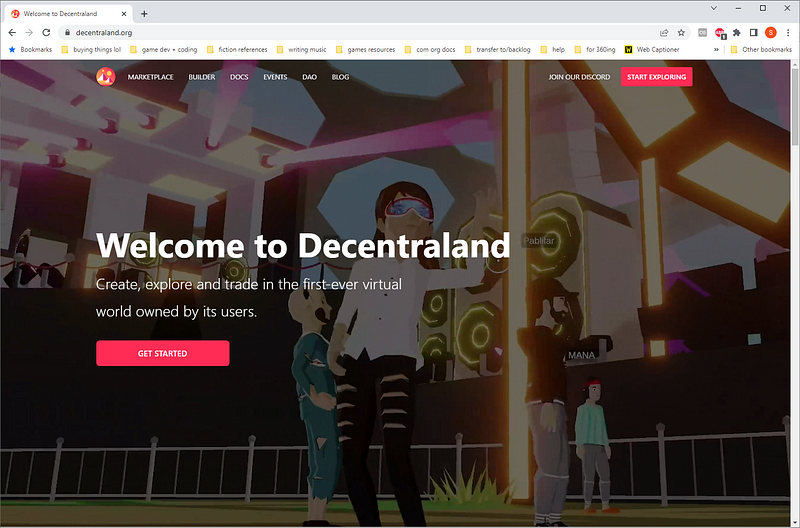 The obvious
buttons will bring you into the game or to the desktop launcher without many more steps.
The obvious
buttons will bring you into the game or to the desktop launcher without many more steps.
Somnium Space is a little more arcane, with more vocab words to parse and buttons to click without really knowing what they mean. The desktop client I used, without a VR headset, is labeled “VR Client.” I could not tell you how it compares to the web version. Trying to open it made my computer, which gets by with most current multiplayer video games, grind to a halt.
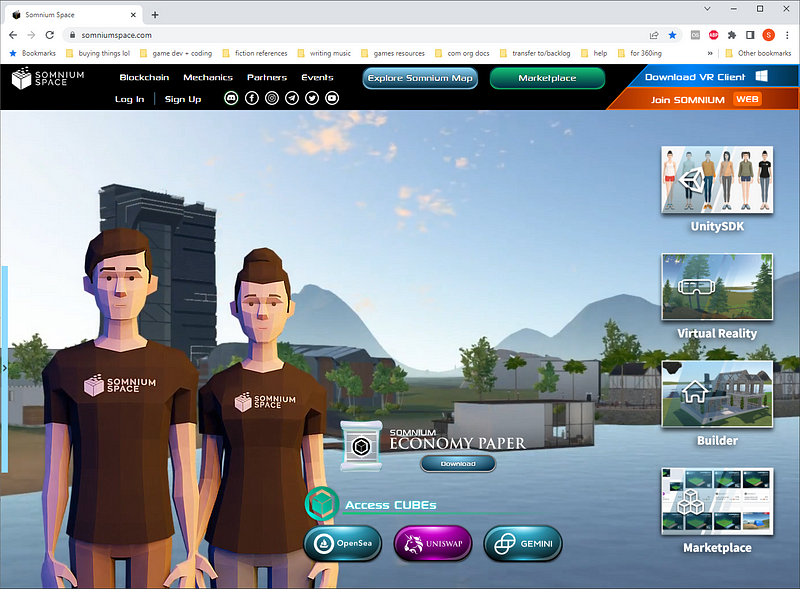 Getting
into the metaverse from this website took me longer than I’d like to admit.
Getting
into the metaverse from this website took me longer than I’d like to admit.I found that almost all metaverses are in prototype stages of development. If they are at all open to the public, most will not let you in without a crypto wallet and a small deposit. Among the blockchain services that are actually live, I was only able to spend time in two Ethereum-backed metaverses I’ve named already. I then watched a lot of footage of WAX-based metaverse Imersys because I could not get in given my rules. The following peek under the surface is not a comprehensive overview of what the metaverse could offer, but an attempt at simulating what most people will encounter right now.
Decentraland
The “first ever virtual world owned by its users” has a default avatar creator which comfortably resembles Nintendo’s Miis or the Xbox 360 Avatar Editor. The world is bright, simple, and unassuming enough that I don’t feel like I’m missing something without VR.
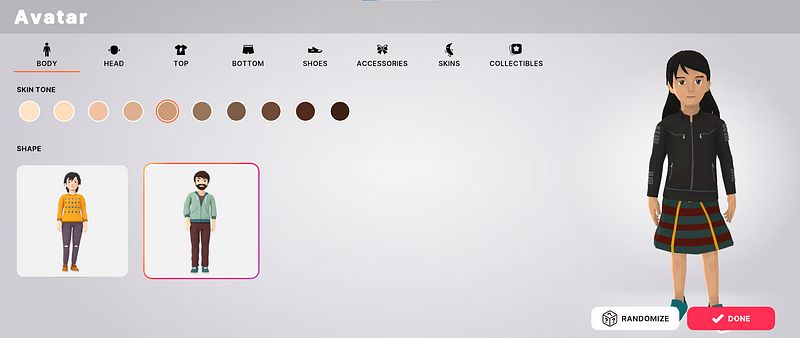
Login brings you to Genesis Plaza, where you can easily find what events and spaces are popular without having to open a menu. Below, a cafe leads to the rest of the plaza to offer shopping, event space, and a currency exchange all maintained by the organizing social structure of Decentraland, the Decentralized Autonomous Organization (DAO).
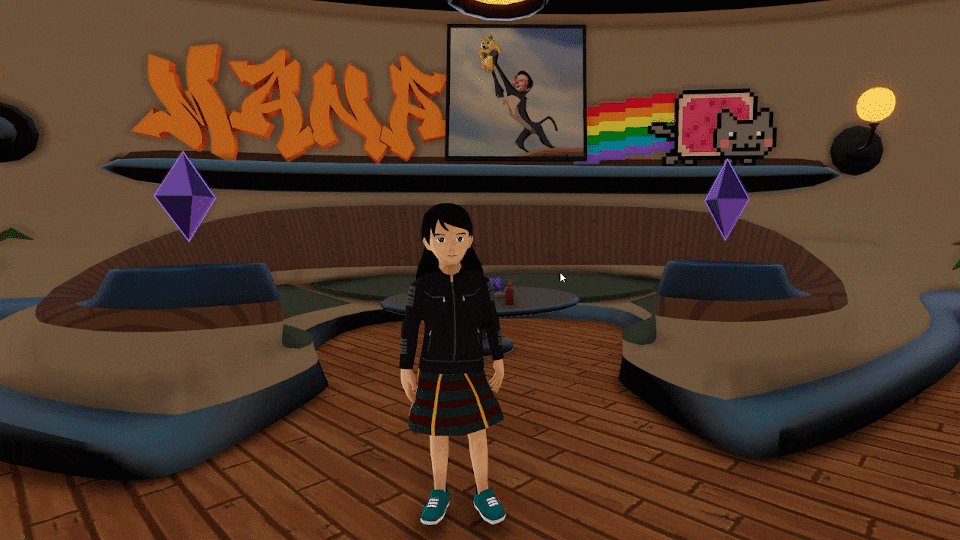 My avatar
using the default dancing emote in the Genesis Plaza Cafe. Hover your mouse or long press on mobile
to get a breakdown of all the images and memes behind me.
My avatar
using the default dancing emote in the Genesis Plaza Cafe. Hover your mouse or long press on mobile
to get a breakdown of all the images and memes behind me.During the month of April, there were enough events that I could pop in any night after work and find some kind of DJ set, livestream, movie screening, or game event to attend without much prior planning. While only the live gambling halls ever exceeded 50 people in attendance during my visits (touting 500–700 people), most events are lively with many users utilizing text chat. Many of these events offer free POAP (proof of attendance protocol) NFTs, which often take the form of fashion items. Distribution of this class of NFT is limited to a period of time and a digital location, so if only a few are claimed you could flip it for crypto down the line. However, without a linked wallet to store the freebies in, I could only look on as others claimed their free sunglasses and lanyard.
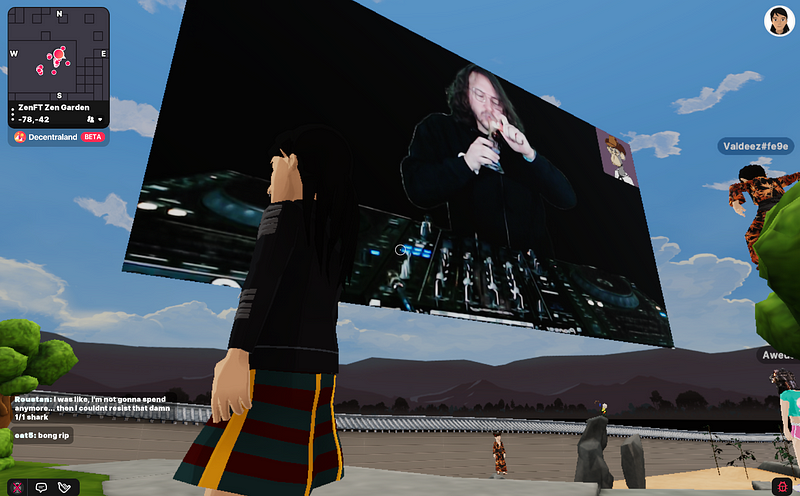 A live DJ
set I stumbled into entirely by accident on a Tuesday night.
A live DJ
set I stumbled into entirely by accident on a Tuesday night.The crowds of Decentraland seem inviting, but after some I found it very clear which users haven’t connected a crypto wallet, based on who was decked out in only free POAPs instead of a purchased outfit. On further visits, the software continued to prompt me to connect a crypto wallet. Although there are no restrictions attached to being dressed like a guest account, I did feel a little punished. Clearly new users are often ignored in community spaces on other platforms, but in Decentraland, it was nearly impossible to elicit replies from the huddled and fashionable once I left Genesis Plaza.
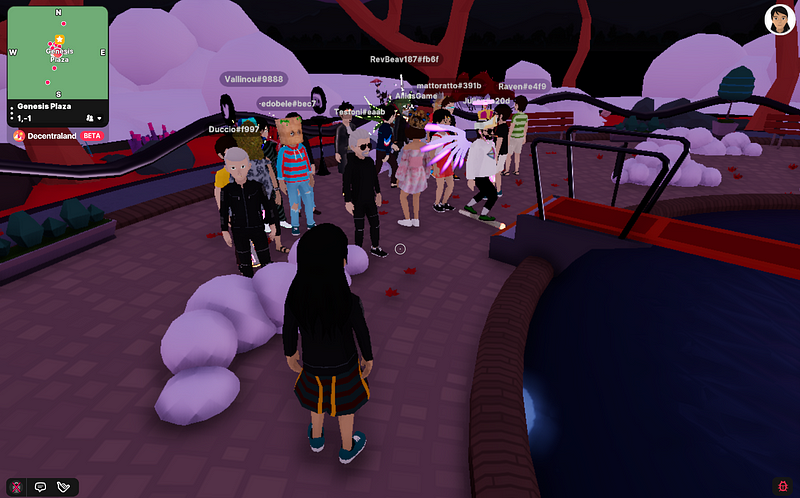 Many new and
returning users idling at Genesis Plaza. I’ve found it safe to assume the more visually extravagant
or distinct avatars are wearing unique NFTs rather than POAPs.
Many new and
returning users idling at Genesis Plaza. I’ve found it safe to assume the more visually extravagant
or distinct avatars are wearing unique NFTs rather than POAPs.The large volume of users is exciting in Decentraland, but the events began to melt together after a week. At first I thought I had this experience because I refused to make a wallet and was stuck with a default avatar, but because I was constantly prompted to buy or claim crypto, I began to to think my resulting alienation was the intended experience. That is, Decentraland functions as a consumer onboarding process for crypto whose purpose is to encourage you to buy more. With not much else to do without investing, I left this metaverse disappointed and unfashionable.
Somnium Space
My time in Somnium Space was brief and antagonistic. Where Decentraland put me on the margins for lacking crypto, Somnium Space made me feel excluded for lacking a VR headset, even before entering.
Booting up the desktop installer for Somnium Space requires a VR launcher and obtusely refers to entering without VR as “2D mode.” When I got in, the camera controls required me to constantly click-and-drag to change my point of view, work that a headset’s motion tracking would do automatically. (In contrast, Decentraland, and most video games since 1994, track point of view to where a user’s cursor points.) Somnium Space’s control scheme is deeply frustrating; beyond going against many decades of social conditioning, it makes it very easy to accidentally click outside the Somnium Space window without noticing.
I feel extremely disconnected moving about Somnium Space. Upon my first login, I am met with the sound of crickets. I’m asked to pick from a pool of uneditable avatar options before being plopped into a ghost-like open-air mall plaza. The window is forced into the aspect ratio for VR despite selecting otherwise. I have a much wider visual field than I really need.
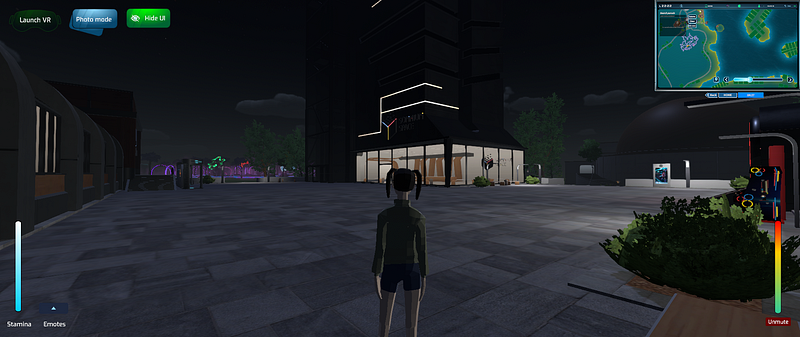 The Somnium
Space main plaza. This space is constantly a ghost town for me and exists at such a strange scale as
if inviting the emptiness.
The Somnium
Space main plaza. This space is constantly a ghost town for me and exists at such a strange scale as
if inviting the emptiness.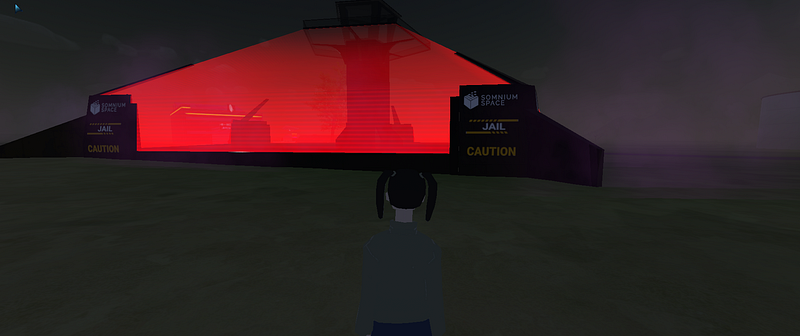 A strange
jail just outside the main Somnium Space plaza. I couldn’t discern what purpose this actually
serves.
A strange
jail just outside the main Somnium Space plaza. I couldn’t discern what purpose this actually
serves.In a digital world trying to resemble our day-to-day lives, some inconveniences can be necessary design choices. Operating like bus stops, Somnium Space has fixed teleportation terminals in the world. Rather than letting you zip around the world at will, you have to walk your avatar to these terminals. Though moving around is frustrating because of the previously-described camera controls and a restrictive running meter, I like being moved through space by a common structure like transportation. In the physical world, waiting for trains is often an unavoidable part of getting in and out of the city. The teleportation system in Somnium Space is a familiar and relatively low-tech system that compels me to take my time, looking at the user parcels I walk past.
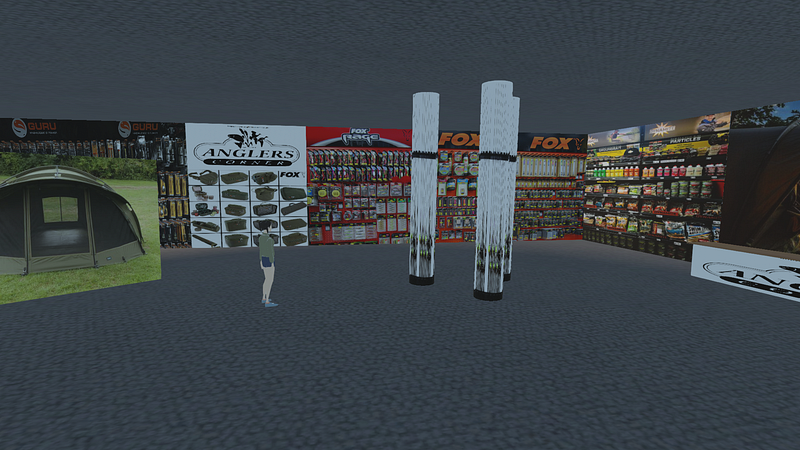 A facade of
a fishing shop. A long-form Youtube video explaining how to cast a line is projected on the
accessible roof, audio booming throughout the store.
A facade of
a fishing shop. A long-form Youtube video explaining how to cast a line is projected on the
accessible roof, audio booming throughout the store.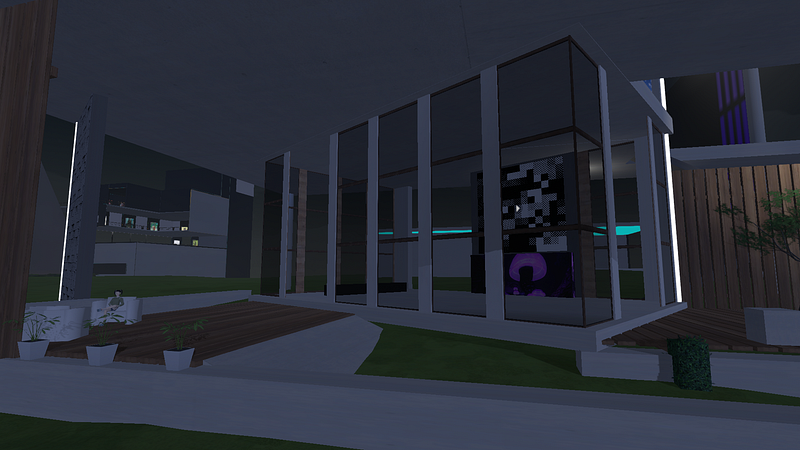 An
open-air, modernism, and MC Escher kind of user parcel. I sat down to flip through my phone before
continuing my walk through user-made locales.
An
open-air, modernism, and MC Escher kind of user parcel. I sat down to flip through my phone before
continuing my walk through user-made locales.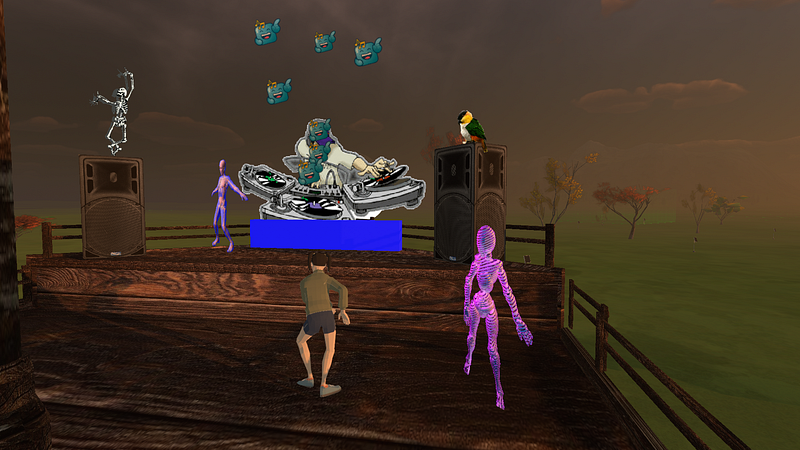 My avatar,
dancing alone on a pirate party ship.
My avatar,
dancing alone on a pirate party ship. On the same
ship, you can walk towards the plank and suddenly be enveloped in this sphere. This feels very made
for VR, but the shift in scale is still exciting.
On the same
ship, you can walk towards the plank and suddenly be enveloped in this sphere. This feels very made
for VR, but the shift in scale is still exciting.Unfortunately for Somnium Space, it was completely unpopulated every time I tried to visit. I did not run into another user once. Looking at their events calendar, there is not much in the way of unique programming and the timing of regular events seems to defy any working person’s schedule. Without a living social context to place what I’m looking at, the scenes of Somnium Space felt more like a hollowed out Second Life than a distinct meeting place of the future.
Immersys
Backed by the Wax blockchain, which self-reports an annual carbon footprint of 110 tonnes to Ethereum’s currently reported 59.52’s million tons, Immersys asks only for a 5 WAXP deposit (~US$1.34 at the time of writing) to join. Given the difference in environmental impact and affordability, I considered breaking my “no crypto” rule for this piece.
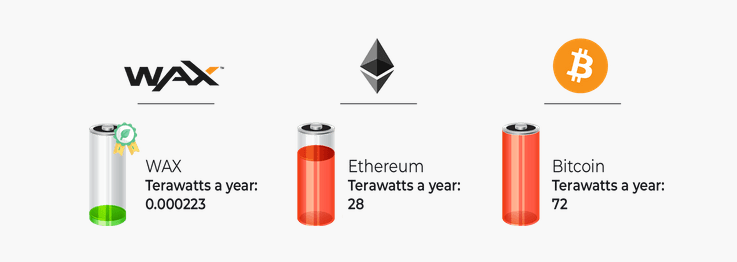 A graphic
borrowed from the Wax website.
A graphic
borrowed from the Wax website.Because of Wax’s lower value, the easier-to-access trading sites would only let me exchange a minimum of 30 USD. While still a small amount of money, paying that much as an entrance fee felt against the spirit of this project. In the end, I started making a DeFi wallet only to discover at the end of the process that their trading platform is currently waitlist only. While I did not get into Immersys, this act of hunting for pocket change echoes the Immersys experience.
This metaverse is a play-to-earn service, which is less generous than it sounds. Where socializing is prioritized in other metaverses, running around vast and unstructured landscapes to mine, chop wood, and do simulated tasks to get raw material are your main ways of engaging the world.
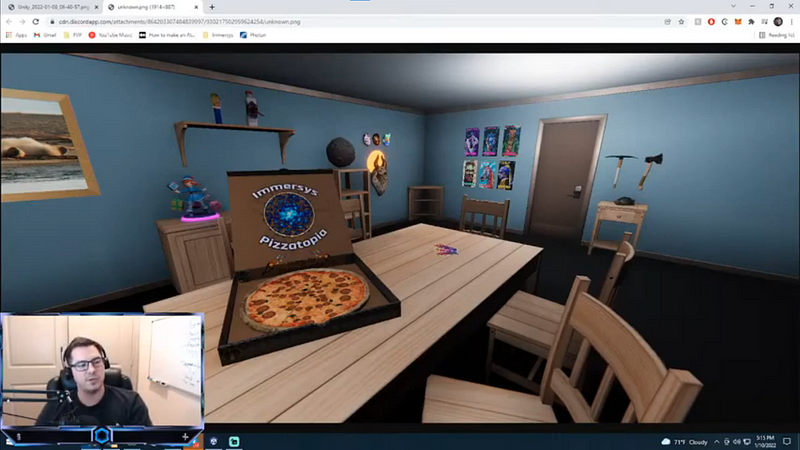 A static
image of what user property may look like down the line. This is not yet in the game as the
last major update only included changes to crafting and gathering.
A static
image of what user property may look like down the line. This is not yet in the game as the
last major update only included changes to crafting and gathering.While this might sound like a typical crafter-gatherer game of the sort popularized by Minecraft, the twist in Immersys is that not every tree or rock will produce materials. Cutting down a tree gives you a chance to get a wood log NFT or, at even narrower odds, the blueprint to make and sell log NFTs.
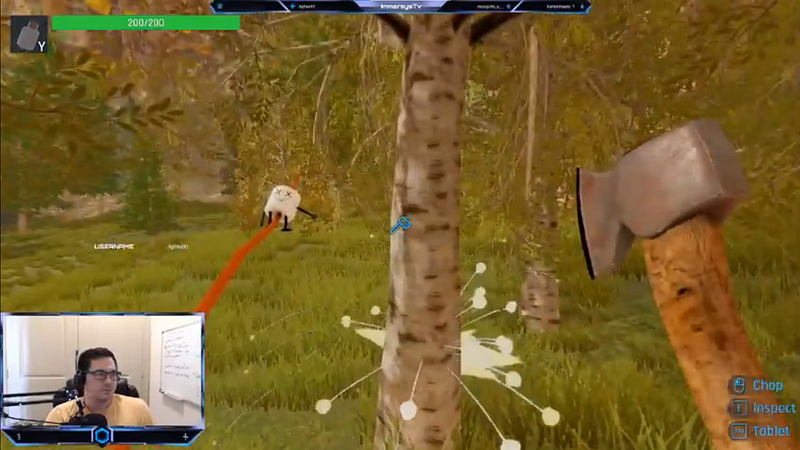 Daniel K,
CEO and co-founder of Immersys, live streaming while on the platform. He spends two hours cutting
down trees and gets neither any wood nor the blueprint.
Daniel K,
CEO and co-founder of Immersys, live streaming while on the platform. He spends two hours cutting
down trees and gets neither any wood nor the blueprint.This blueprint, also an NFT, is sometimes one-of-a-kind, depending on the resource. Acquiring a cherry wood log blueprint would make you the only possible producer of cherry wood log NFTs in the world. Users play a game of chance with others to raze the world’s resources for the rights, not the skill, to produce goods and sell them for crypto.
Immersys is nearly the exact opposite of what I had hoped a metaverse backed by a less environmentally destructive blockchain would be like. A large part of what gives cryptocurrency its value is mining, which is the process of decrypting data and adding it to the respective blockchain. Carbon-negligible cryptocurrencies like Wax take turns, decided in democratic vote by their token holders, to add their decryption work to the blockchain, thus reducing their carbon footprint. Other blockchains lack any organization. This encourages crypto miners to compete to post their decryption work first by using the fastest and most wasteful mining processes and hardware available. This free market competition produces the enormous energy consumption stats outlined in a prior graphic.
While all observed secondhand, the promises contained in this vision of the metaverse feel laid bare more so than the bright and populated Ethereum lands I visited. As it stands, play-to-earn platforms and assets such as the POAPs of Decentraland, are a bootstrapping fantasy that remind me of the allure of gold prospecting — if you only invest well, work hard, play smart, and get lucky, you’ll find hidden riches.
For more news, discourse, and resources on immersive and emerging forms of nonfiction media, sign up for our monthly newsletter.
Immerse is an initiative of the MIT Open DocLab and Dot Connector Studio, and receives funding from Just Films | Ford Foundation, the MacArthur Foundation, and the National Endowment for the Arts. The Gotham Film & Media Institute is our fiscal sponsor. Learn more here. We are committed to exploring and showcasing emerging nonfiction projects that push the boundaries of media and tackle issues of social justice — and rely on friends like you to sustain ourselves and grow. Join us by making a gift today.